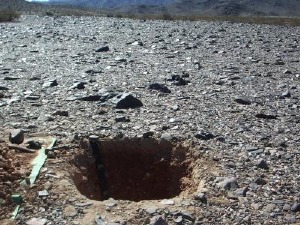Mar 1 2008
A UC Riverside-led study in the Mojave Desert, Calif., has found that soils under "desert pavement" have an unusually high concentration of nitrate, a type of salt, close to the surface. Vulnerable to erosion by rain and wind if the desert pavement is disrupted, this vast source of nitrate could contaminate surface and groundwaters, posing an environmental risk.
 Desert pavement overlying soil.
Desert pavement overlying soil.
Study results appear in the March issue of Geology.
Desert pavement is a naturally occurring, single layer of closely fitted rock fragments. A common land surface feature in arid regions, it has been estimated to cover nearly half of North America's desert landscapes.
Nitrate, a water soluble nitrogen compound, is a nutrient essential to life. It is also, however, a contaminant. When present in excess in aquatic systems, it results in algal blooms. High levels of nitrate in drinking water have been associated with serious health issues, including methaemoglobinaemia (blue baby disease, marked by a reduction in the oxygen-carrying capacity of blood), miscarriages and non-Hodgkin's lymphoma.
Salts, including nitrate, are formed in deserts as water evaporates on dry lake beds. These salts then get blown on to the desert pavement by winds. Other contributors of nitrate to desert pavement soils are atmospheric deposition (the gradual deposition of nutrient-rich particulate matter from the air), and soil bacteria, which convert atmospheric nitrogen into nitrate that is usable by plants and other organisms.
Ordinarily, in moist soils, plants and microbes readily take up nitrate, and water flushing through the soils leaches the soils of excess nitrate.
But desert pavement, formed over thousands of years, impedes the infiltration of water in desert soil, restricting plant development and resulting in desert pavement soils becoming nitrate-rich (and saltier) with time.
"After water, nitrogen is the most limiting factor in deserts, affecting net productivity in desert ecosystems," said Robert Graham, a professor of soil mineralogy in the Department of Environmental Sciences and the lead author of the research paper. "The nitrate stored in soils under desert pavement is a previously unrecognized vast pool of nitrogen that is particularly susceptible to climate change and human disturbance. Moister climates, increased irrigation, wastewater disposal, or flooding may transport high nitrate levels to groundwater or surface waters, which is detrimental to water quality."
In their study, Graham and his colleagues sampled three widely separated locations with well-developed desert pavement in the Mojave Desert. The locations were selected to represent a variety of landforms commonly found in the desert. The researchers found that the nitrate they observed in association with desert pavement was consistent across the landforms.
"Deserts account for about one-third of Earth's land area," Graham said. "If our findings in the Mojave can be extrapolated to deserts worldwide, the amount of nitrate - and nitrogen - stored in near-surface soils of warm deserts would need to be re-estimated."
Graham and his team of researchers found that nitrate concentration in soils under desert pavement in the Mojave reached a maximum (up to 12,750 kilograms per hectare) within 0.1 to 0.6 meter depth. In contrast, at each location they studied, the soils without desert pavement had relatively low nitrate concentrations (80 to 1500 kilograms per hectare) throughout the upper meter. "In these nonpavement locations, water was able to infiltrate the soil and transport the nitrate to deeper within the soil," Graham explained.
The researchers note in the paper that desert land use - road construction, off-road vehicle use, and military training - often disrupts fragile land surfaces, increasing surface erosion by rain and wind. According to them, nitrogen-laden dust transported by wind from disturbed desert pavement soils may impact distant nitrogen-limited ecosystems, such as alpine lakes.
Furthermore, the researchers note that increased soil moisture resulting from climate change increases the potential for "denitrification" - a naturally-occurring process in soil, where bacteria break down nitrates to return nitrogen gas to the atmosphere. "Denitrification also produces nitrous oxide, a major greenhouse gas," Graham said.
Next in their research, Graham and his colleagues will examine the spatial distribution of desert pavement throughout the Mojave Desert to explore how different levels of nitrate are associated with different kinds of desert pavement. Together with UCR's David Parker, a professor of soil chemistry, they will look in the desert also for perchlorate, which may be associated with nitrate.